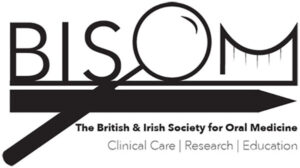
What are the aims of this leaflet?
This leaflet has been written to help you understand more about mucous membrane pemphigoid. It explains what it is, what causes it, what can be done about it, and where you can find more information.
What is mucous membrane pemphigoid?
Mucous membrane pemphigoid (MMP) is the most up-to-date term for this condition. Other names include cicatricial pemphigoid, oral pemphigoid and ocular pemphigoid.
MMP is an uncommon blistering condition which most frequently affects the lining of the mouth and gums. Other moist surfaces of the body (known as mucous membranes) can also be affected. This includes the surface layers of the eyes and inside of the eyelids, the inside of the nose, the throat, oesophagus and the genitalia. The skin is sometimes affected by a few scattered blisters on areas such as the face, neck and scalp. MMP usually starts around the age of 70, although some cases have been reported in childhood. It is not usually a serious condition in the mouth, but a diagnosis of any type is important as it will alert the specialist to the possibility that the eyes may become involved. Eye involvement (known as ocular cicatricial pemphigoid or ocular MMP) does not occur in all people with MMP. However, this condition is potentially serious as it may cause scarring and affect your eyesight. Scarring may also affect the throat and the genitalia. It may be very serious if the larynx is affected.
What causes mucous membrane pemphigoid ?
The cause of MMP is unknown. It is considered to be an autoimmune disease. The antibodies that defend your body against infections react with the surface layer of the mouth (or other mucous membranes) causing blisters, which usually break down to leave ulcers. MMP is not contagious or due to food allergy.
Is mucous membrane pemphigoid hereditary?
MMP is not an inherited condition. However, it may occur in patients with a family history of autoimmune disease.
What are the symptoms of mucous membrane pemphigoid ?
- In mild cases, MMP may just involve the mouth, causing occasional blisters. These are usually painless until they burst and form ulcers. Ulcers typically cause burning or stinging, especially when eating spicy foods, citrus fruits, drinking hot beverages/alcohol or using mouthwashes that contain alcohol. If the gums are affected, they may feel sore, particularly when brushing teeth.
- In more severe cases, the throat, eyes, nose, genitalia or skin may also be affected. If the eyes are affected, they may be red, feel gritty or sore and conjunctivitis may be diagnosed.
- Some people with MMP get a stuffy blocked nose and have blood-tinged mucus or nose bleeds, or notice a change in their voice. Occasionally, they may experience some difficulty swallowing.
- If the genitals are affected, blisters or ulcers may appear and tend to persist unless treated.
- There may be scattered skin blisters, often on the scalp but occasionally on the face, trunk or limbs.
What does mucous membrane pemphigoid look like?
In the mouth, MMP typically appears as red, blistered or ulcerated patches on the inner cheeks, gums or roof of the mouth and may be the only sign of this condition.
Active MMP in the eye is usually red in appearance and may be weeping. If not treated urgently, this may lead to scarring and impaired vision. Skin blisters may form crusts and eventually heal with a superficial scar.
How is mucous membrane pemphigoid diagnosed?
MMP cannot be diagnosed solely by its appearance as other conditions can look very similar. One or two small samples of tissue (biopsy) may be taken by the specialist team (under a local anaesthetic), usually inside the mouth. The diagnosis can then be made by looking at the samples under a microscope and testing them for specific antibodies associated with MMP. A blood test may also be used to detect these antibodies.
A referral to a specialist may be needed for early diagnosis:
- an eye specialist (ophthalmologist) to check for early signs of pemphigoid involving the eyes
- an ENT specialist for ear, nose and throat symptoms
- a dermatologist or an oral medicine specialist for the skin and mouth.
Care from a multidisciplinary team is very important.
What is the long-term course of mucous membrane pemphigoid ?
MMP is usually brought under control with medication such as tablets or injections. Tablets may be needed for several years, but in some patients the condition can go into long-term remission and eventually medication may be stopped.
How can mucous membrane pemphigoid be treated?
The doctor will discuss treatment options and help patients choose the most suitable medication. This will depend on the severity of symptoms, the person’s general health, and potential medication side effects.
Topical treatments (ointments, creams or solutions you apply to your skin):
Most patients will be prescribed topical treatments for each affected site.
For the mouth:
- Anaesthetic (analgesic) mouthwashes are available for soreness and are particularly helpful if used before meals. Benzydamine mouthwash may be helpful.
- Topical steroids which can be applied locally to the mouth are helpful for most people, but often require additional oral medication (tablets). Topical steroids are available as mouthwashes, sprays, pastes and small pellets which dissolve in your mouth. The specialist may also consider the use of topical steroids put inside a custom made gum shield. Topical steroids can sometimes cause oral thrush which can be easily treated or prevented with topical antifungals.
- If the gums are affected (desquamative gingivitis), it is important to keep the teeth as clean as possible by regular and effective tooth brushing. If not, a build-up of debris (known as plaque) can make the gum condition worse. A dentist or a dental hygienist will be able to give oral hygiene advice and may arrange an appointment for extra teeth cleaning using professional equipment.
- An antiseptic mouthwash or gel may be recommended to help plaque control, particularly at times when the gums are sore. Daily hydrogen peroxide mouthwash (Peroxyl®) or occasional chlorhexidine (Corsodyl®) twice per week are examples. If possible, avoid a mouthwash containing alcohol as this may be painful.
For the skin:
- Corticosteroid creams or ointments are helpful and can be prescribed by the doctor.
For the eyes:
- Treatment will be directed by an ophthalmologist and may include lubricants, topical corticosteroid or other eye drops, although oral medication is needed for most patients. (See below)
Systemic (whole body) treatment:
- In people who are more severely affected by MMP or when topical treatment has not helped, systemic treatment (taken by mouth or by injection into a vein) may be required usually for several months or years. The specialist will discuss risks and benefits of the different drug options available. Regular blood tests are required to check for unwanted effects of treatment, especially in the first weeks of treatment.
- Oral steroids may be prescribed for a few months in high doses and then for longer periods at low doses.
- Other tablets used to treat MMP include dapsone, sulfamethoxypyridazine (SMP), sulfapyridine or other antibiotics such as tetracycline combined with nicotinamide.
- Immunosuppressant drugs such as azathioprine, mycophenolate mofetil, methotrexate, cyclophosphamide or rituximab may be needed for severe MMP. These treatments help by suppressing the body’s immune system.
Self-care (What can I do?)
- Avoid spicy, acidic or salty foods if these make your mouth sore.
- Have your mouth checked on a regular basis by a dentist, or oral specialist.
- Keep your teeth clean by using a soft brush and small interdental brushes
- Choose a toothpaste with a mild flavour and free from the foaming agent, sodium lauryl sulphate (SLS).
- Stop smoking and reduce your alcohol intake to recommended limits.
- For the nose, nasal douching (sniffing a saline solution into the nostrils) can be helpful.
- For the eyes, please seek precise advice from your ophthalmologist.
Where can I get more information about mucous membrane pemphigoid?
Weblinks to patient support groups:
PEM Friends: https://www.pemfriends.org.uk/
International Pemphigus and Pemphigoid Foundation: www.pemphigus.org
The Pemphigus Vulgaris Network: http://www.pemphigus.org.uk/
Web links to detailed leaflets:
http://emedicine.medscape.com/article/1062534-overview
http://dermnetnz.org/immune/cicatricial-pemphigoid.html
Jargon Buster: https://www.skinhealthinfo.org.uk/support-resources/jargon-buster/
This leaflet has been produced in conjunction with the British and Irish Society for Oral Medicine (BISOM).

Please note that the BAD provides web links to additional resources to help people access a range of information about their treatment or skin condition. The views expressed in these external resources may not be shared by the BAD or its members. The BAD has no control of and does not endorse the content of external links.
This leaflet aims to provide accurate information about the subject and is a consensus of the views held by representatives of the British Association of Dermatologists and the British Society for Oral Medicine: individual patient circumstances may differ, which might alter both the advice and course of therapy given to you by your doctor.
This leaflet has been assessed for readability by the British Association of Dermatologists’ Patient Information Lay Review Panel
BRITISH ASSOCIATION OF DERMATOLOGISTS PATIENT INFORMATION LEAFLET
PRODUCED | JUNE 2015
UPDATED | SEPTEMBER 2019, MAY 2023
NEXT REVIEW DATE | MAY 2026
Download a PDF of this page using the link below:
Download File